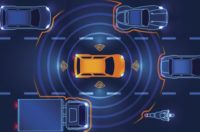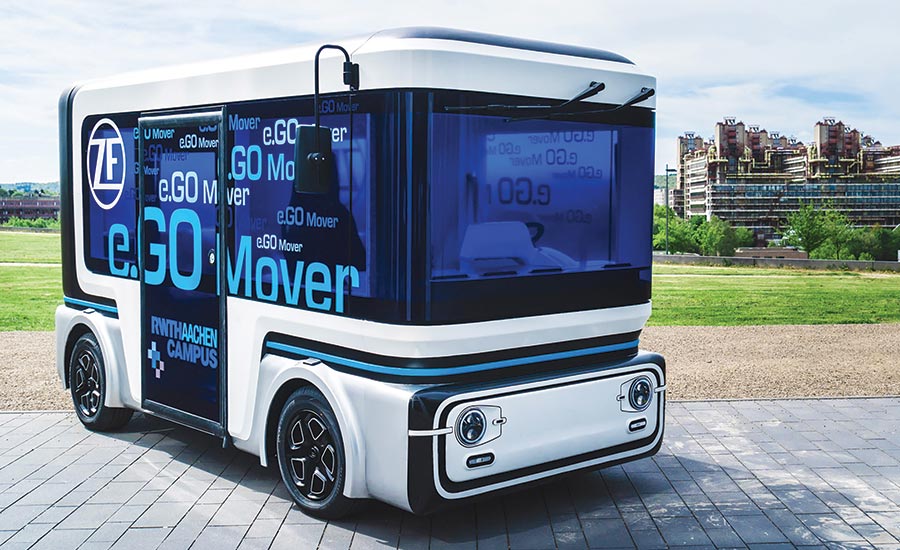Autonomous vehicle opportunities and challenges
Recent industry developments are looking to save lives, reduce injuries, and spread mobility equitably, but education—of developers and consumers—is one important element to AV technology development and adoption.




















This year kicked off where 2018 finished when a huge number of developments were announced in autonomous and connected vehicles. The biggest platform for these reveals, demonstrations, and announcements was the CES 2019 Show in Las Vegas, which saw an unprecedented amount of automotive applications being showcased and a glimpse given to a world that is fast becoming a reality. As such, future mobility and the general term of autonomy is resonating with more and more people all the time, and they are waking up to the fact that the way they move in personal transportation will be revolutionized.
Shuttle and virtual developments
ZF Friedrichshafen AG was one of the exhibitors at the show with plenty to talk about. One of the announcements from the German company was a partnership on shared mobility solutions with Transdev and e.GO. The trio revealed they will work together on a new product, the e.Go Mover shuttle, which will use a Transdev operating system and components from ZF. Prioritizing the French and German markets—and despite only starting work on the shuttle at the beginning of 2019—a fully functional solution will be offered by 2020.
The concept of a fully electric, connected, and automated shuttle might not be groundbreaking, but the involvement from ZF is big news. The Tier 1 supplier is equipping the e.Go Mover with electric-drive systems, steering systems, and brakes, as well as the ProAI central computer, which uses artificial intelligence and sensors to enable automated driving elements. Transdev will provide the supervision system, connected infrastructure, and client application.
“Automation, electrification, and networking are critical enablers as the transport of people and goods continually increase in urban centers,” said Wolf-Henning Scheider, CEO of ZF Friedrichshafen AG. “With our extensive systems competence, ZF is enabling and shaping next-generation mobility. Urban mobility choices like ride-hailing are one of the biggest drivers behind the development of autonomous driving.”
More collaborations were revealed in Las Vegas. Continental and Automotive Artificial Intelligence (AAI) revealed their plans for virtual development of ADAS (advanced driver-assistance systems) and AD (automated driving) systems. The testing program—which will allow up to 5000 mi (3100 km) to be driven virtually in a single hour—is designed to engineer out risk and engineer in safety for people around and in the vehicle, whether those inside are fully in control of the vehicle or not.
“Our ultimate goal is always absolute safety, and this is especially true for automated driving,” said Karl Haupt, head of the ADAS business unit at Continental. “Resources in vehicle tests are limited, and virtual testing can provide fast feedback for developers. While a real vehicle can drive around 10,000 test km (6000 mi) in a physical test in one month, today up to 8000 km (5000 mi) an hour are possible with virtual simulation.”
Haupt says that the distance figure will increase in the future with the help of startup AAI, which comes to the automotive market at an optimum time to broaden its profile and appeal.
“For our young company, partnering with a technology corporation such as Continental is a seal of quality,” said Isabel Metz, head of business development at AAI. “Continental’s customers will also benefit because a faster test procedure guarantees safer, more robust, and more cost-effective products.”
The collaboration has been designed to establish a clear division between vehicle simulation and environment simulation. AAI will be responsible for the environment and provide software that enables vehicles to be driven in a virtual world. Individual parameters determine the weather, traffic infrastructure, road markings, and objects such as road signs and potholes.
In addition, AAI will integrate traffic elements into the virtual simulation environment using AI (artificial intelligence) as well as machine-learning algorithms to train the behavior of traffic participants, resulting in aggressive, moderate, and defensive driver profiles. The long-term goal is to create a “replica of the world” and realistically simulate all road users and environmental factors.
Building future careers
Away from product announcements and imminent developments, many organizations are keeping an eye on who—or what—will be developing future generations of autonomous vehicles. Those individuals looking to embark on a career in the automotive industry now or in the years ahead will be armed with a new set of skills, requirements, and expectations as the design and engineering challenges of future vehicles evolve.
“Transport needs to be—and, realistically, can be—remodeled around the potential of intelligent mobility technologies into a new ecosystem: a host of options for transportation made available as part of an integrated, managed system, and all founded on more use of autonomous vehicles and networks of sensors and information sharing,” said Dr. Daniel Auger from Cranfield University’s Advanced Vehicle Engineering Centre. The university has recently launched a course focused on autonomous and connected vehicles.
“The nuts and bolts of the necessary technologies for intelligent and autonomous transport are already in place,” believes Auger. “Tesla already feels comfortable in claiming that all its models of cars contain the hardware needed to be fully self driving. But we’re also at a stage of uncertainty when it comes to which of the technologies and options are going to be the most commercially viable, those that will be seized upon by the public, and those that will be left standing. High-end cars have, of course, included elements of automation for some time—such as adaptive cruise control, collision braking, automatic parking, lane-keep assist, sign recognition—and these features will cascade eventually into most models, by choice and eventually possibly via legislation.”
Auger maintains that what needs to be done is to recruit more of the younger generation who have skills that are suited to developing future mobility solutions. Sounds straightforward given the growth in the industry within OEMs, Tier 1s, and those further down the supply chain, but there may be trouble ahead—in the UK at least.
“Research by the UK’s Transport Systems Catapult predicts a skills gap of 742,000 people by 2025, with a particular need for ‘high value’ digital skills,” he said—culminating in a big hit to GDP by not having the skills to exploit the opportunities. “At the same time, because of the level of future potential, jobs in the sector are going to be in high demand.”
One job site report in late 2018 that searches for autonomous vehicles’ roles had grown by 668% since 2015 in the U.S. “In other words, engineers are going to need to equip themselves with specialist expertise to be part of the boom,” said Auger. “Based on its data from recruiters, the job site suggests they want to see knowledge of image processing, AI, machine learning, and more specific skills like C and C++, Java, and Python programming.”
Education and the generation game
At the other end of the age spectrum, there is a school of thought that autonomous vehicles could revolutionize transportation for the elderly. Figures suggest that 20% of Americans over 65 years old do not drive, so the appeal of having access to a car that doesn’t need to be driven is likely to be high.
“[Autonomous vehicles] are a critical part of livable communities as we talk to mayors and other officials around the country,” said Nancy LeaMond, Executive Vice President of the U.S. Association of Retired Persons (AARP). “To be successful, people of all ages will need to trust the machine to do the driving, and right now there is a very significant trust gap. A full three-quarters of U.S. drivers of all ages report feeling afraid to ride in a self-driving car.”
Elizabeth Macnab, Executive Director, Ontario Society of Senior Citizens’ Organizations, agrees, highlighting some considerations that should be made to ensure driverless cars are appealing to elderly people: “The vehicles should be affordable to senior citizens on a fixed income and accessible to senior citizens who need to use mobility aids and walking devices to get around. The manufacturers of autonomous vehicles should commit to providing training to elderly people about how to correctly use a driverless car.”
In the UK, thoughts on the matter have seen the country’s Transport Secretary, Chris Grayling, also claim that self-driving cars will transform the lives of the elderly and the disabled. “The potential benefits of these new technologies for human mobility—and for wider society—are tremendously exciting,” he stated. “Many who can’t currently drive will be able to take to the road. Elderly people or people with disabilities which prevent them from travelling today will discover a new sense of freedom and independence.”
Looking for a reprint of this article?
From high-res PDFs to custom plaques, order your copy today!















